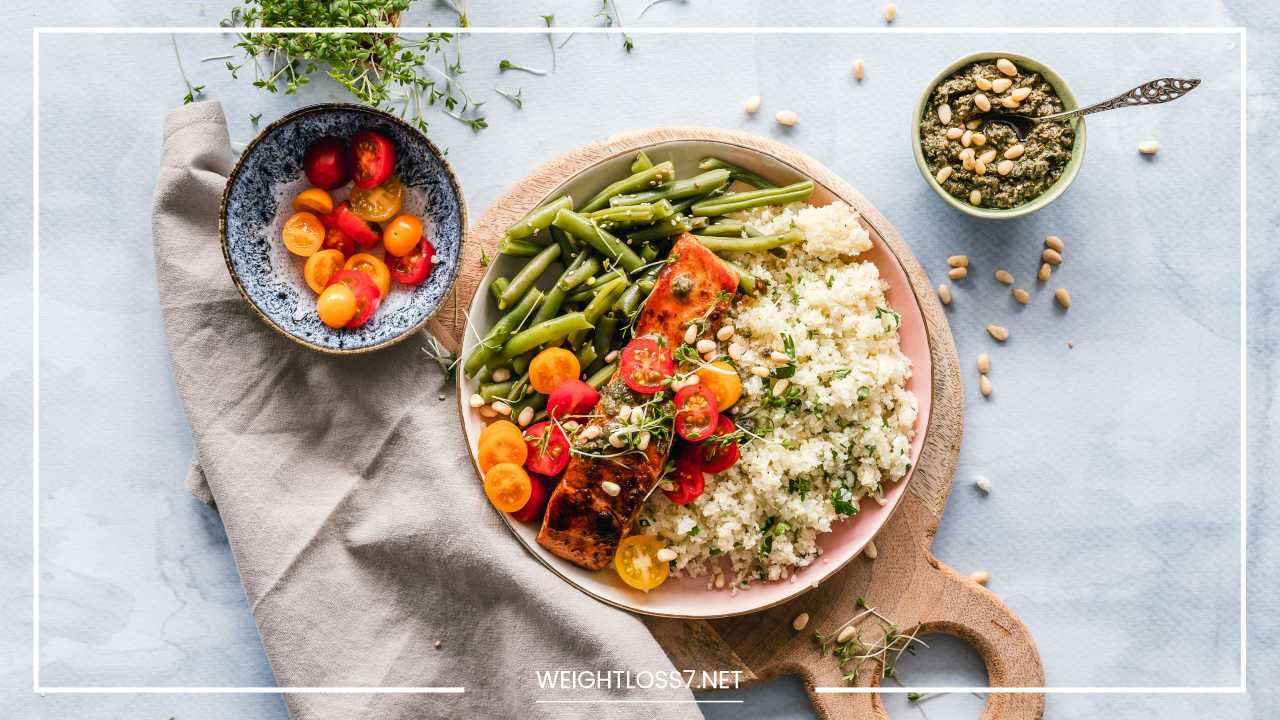Healthy Food: Eat Well, Feel Great

Healthy Food
The Delicious Journey to Healthy Eating: A Guide for Every Lifestyle
Welcome, food enthusiasts and health seekers alike! Buckle up for a delicious adventure into the wonderful world of healthy eating. We all know the age-old adage:
“You are what you eat.” But in today’s fast-paced world, navigating the grocery aisles and whipping up nutritious meals can feel daunting. Fear not!
This comprehensive guide will equip you with the knowledge and inspiration to make healthy eating a joyful and sustainable part of your life.
Why Choose Healthy Eating?
Let’s be honest, healthy eating isn’t just about fitting into your favorite jeans (although that’s a pretty sweet bonus!). It’s about fueling your body with the nutrients it needs to thrive. Here’s a glimpse into the benefits you can expect:
- Boosted Energy Levels: Forget the afternoon slump! Balanced meals provide sustained energy throughout the day, keeping you focused and productive. No more reaching for that sugary snack to get a quick pick-me-up.
- Improved Mood and Wellbeing: What you eat can directly impact your mental health. A diet rich in fruits, vegetables, and whole grains has been linked to a positive mood, reduced risk of depression, and better cognitive function. Eating healthy can help you feel your best, both physically and mentally.
- Stronger Immune System: A healthy diet packed with vitamins, minerals, and antioxidants helps your body fight off illness and recover faster. Think of it as building a strong internal defense system to keep you healthy and vibrant.
- Reduced Risk of Chronic Disease: Eating a balanced diet can significantly lower your risk of developing chronic diseases like heart disease, diabetes, some types of cancer, and even Alzheimer’s disease. By making healthy choices now, you’re investing in your long-term health and well-being.
- Weight Management: While healthy eating isn’t just about weight loss, it can certainly help! Eating nutritious foods keeps you feeling full and satisfied, naturally reducing cravings and promoting healthy weight management. You’ll feel better in your body and have more energy for the activities you love.
Building Your Healthy Plate: Understanding Food Groups and Nutrient Powerhouses
Now that you understand the “why” behind healthy eating, let’s explore the “what.” Imagine your plate divided into sections – each representing a crucial food group. Here’s how to fill it up for optimal nutrition:
- Half Your Plate: Fruits and Vegetables: These vibrant powerhouses are brimming with vitamins, minerals, fiber, and antioxidants. Aim for a rainbow on your plate, incorporating a variety of colors for a diverse range of nutrients. Here’s a deeper dive into the benefits:
- Fruits: Think of fruits as nature’s candy! They provide a natural sweetness along with essential vitamins like Vitamin C, A, and K. Berries are particularly rich in antioxidants, which can help protect your cells from damage.
- Vegetables: Don’t underestimate the power of veggies! They come in a vast array of shapes, sizes, and colors, each offering unique benefits. Leafy greens are packed with calcium and iron, while cruciferous vegetables like broccoli and cauliflower are known for their cancer-fighting properties.
- One Quarter Your Plate: Whole Grains: Brown rice, quinoa, whole-wheat bread, and oats – these complex carbohydrates provide sustained energy and keep you feeling full for longer. Unlike refined grains that cause blood sugar spikes, whole grains release energy slowly, keeping you focused and avoiding energy crashes.
- One Quarter Your Plate: Lean Protein: Fish, chicken, beans, lentils, and tofu are excellent sources of protein for building and repairing tissues. Choose lean cuts to minimize saturated fat intake. Protein is essential for muscle growth and repair, and it also helps you feel satisfied after eating.
- Healthy Fats: Don’t shy away from good fats! Avocados, nuts, seeds, and olive oil are essential for healthy brain function, cell growth, and nutrient absorption. Opt for these in moderation. Healthy fats also help your body absorb fat-soluble vitamins like A, D, E, and K.
Bonus Tip: Don’t forget about dairy! Low-fat milk, yogurt, and cheese provide calcium and other vital nutrients for strong bones and teeth. Choose fortified options for an extra boost of vitamin D.
Healthy Eating Hacks for Every Lifestyle: Making it Work for You
Here’s the beauty of healthy eating – it’s adaptable! Whether you’re a busy professional, a student on the go, or a parent juggling a million responsibilities, there are ways to integrate healthy choices into your daily routine:
For the Busy Bee:
- Meal Prep is Your BFF: Dedicate a portion of your weekend to prepping healthy meals for the week. Pre-chop veggies, cook brown rice in bulk, and portion out protein sources like grilled chicken or baked tofu. When hunger strikes, you’ll have healthy options readily available in containers, saving you precious time and preventing unhealthy grab-and-go choices.
-
Embrace Frozen Produce: Frozen fruits and vegetables are flash-frozen at their peak freshness, locking in nutrients. They’re a convenient and budget-friendly way to add variety to your meals. Toss frozen stir-fry veggies into a quick weeknight skillet meal, or blend frozen berries into a protein smoothie for a refreshing breakfast on the run.
-
One-Pan Wonders: Simplify cleanup with sheet-pan meals. Toss together veggies, protein, and whole grains (like quinoa), drizzle with olive oil and spices, and let the oven work its magic. Experiment with different combinations for a variety-packed and effortless meal prep solution.
-
Snack Smart: Avoid the vending machine trap! Pack healthy snacks like cut-up fruits and vegetables with a dollop of hummus, yogurt with granola and berries, or hard-boiled eggs. Having these readily available will curb cravings and keep you energized throughout the workday.
For the Budget-Minded:
-
Shop in Season: Seasonal produce is typically at its peak freshness and most affordable price point. Check your local farmer’s market for great deals and support local growers. Seasonal fruits and vegetables are also often more flavorful, making them a win-win for your taste buds and your wallet.
-
Plan Your Grocery Trips: Avoid impulse purchases by creating a grocery list based on your meal plan. Stick to the list as much as possible to avoid exceeding your budget. Utilize coupons and loyalty programs to maximize your savings.
-
Get Creative with Leftovers: Repurpose leftover cooked chicken or salmon into salads, sandwiches, or stir-fries. Leftover veggies can be transformed into healthy soups or frittatas. Leftover cooked grains can be used to make breakfast porridge or veggie burgers. Get creative and avoid food waste!
-
Embrace Plant-Based Meals: Beans, lentils, and tofu are budget-friendly sources of protein. Explore vegetarian and vegan recipes to incorporate more plant-based meals into your routine. Not only are they kind on your wallet, but they’re also packed with nutrients and fiber.
For the Picky Eater:
-
Get Involved in the Kitchen: Enlist picky eaters in meal prep. Let them choose veggies they’re willing to try and involve them in chopping or stirring. Ownership can increase their willingness to try new foods. Let them explore different spices and herbs to find flavors they enjoy.
-
Spice it Up! Herbs and spices can add a burst of flavor to even the simplest dishes. Experiment with different flavor profiles to entice picky eaters. Explore cuisines from around the world – Indian curries, Thai stir-fries, or Mexican fajitas – for exciting and flavorful meal options.
-
Think Outside the Box: Disguise healthy ingredients! Sneak pureed vegetables into pasta sauce or mashed potatoes. Make “fun” shapes with cookie cutters out of healthy veggie slices. Presentation can go a long way in making healthy food more appealing to picky eaters.
-
Start Small: Don’t overwhelm picky eaters with drastic changes. Introduce new foods gradually, alongside familiar favorites. Offer small portions to encourage them to try without feeling pressured. Patience and persistence are key!
For the Foodie:
-
Explore New Ingredients: Take your taste buds on an adventure! Look for exotic fruits and vegetables at your local market or specialty store. Experiment with new cooking techniques – try your hand at sous vide cooking, air frying, or fermentation.
-
Elevate Your Salads: Salads can be so much more than just lettuce and tomatoes. Get creative with toppings! Add grilled shrimp, roasted vegetables, quinoa, crumbled cheese, or a variety of nuts and seeds. Experiment with homemade salad dressings for a burst of flavor.
-
Spice Up Your Life: Don’t be afraid to experiment with different spices and herbs. Explore global cuisines and recreate their signature flavors at home. A pinch of turmeric can add an earthy warmth to curries, while smoked paprika lends a Spanish flair to roasted vegetables.
-
Healthy Twists on Classic Dishes: Craving comfort food but want to keep it healthy? Opt for lighter versions of your favorites. Make “zoodle” lasagna by replacing pasta noodles with zucchini ribbons. Use cauliflower rice instead of regular rice in your favorite stir-fry recipe. Get creative with healthy substitutes that satisfy your cravings without sacrificing nutrition.
Remember: Healthy eating is a journey, not a destination. There will be days when you slip up – that’s okay! The key is to be kind to yourself, get back on track with your next meal, and celebrate the progress you make along the way.
By incorporating these tips and strategies, you can make healthy eating a delicious and sustainable part of your life, fueling your body for optimal health and well-being.
Beyond the Plate: Cultivating a Healthy Relationship with Food
Now that you’ve embarked on your healthy eating journey, let’s explore some additional practices to cultivate a mindful and positive relationship with food.
-
Practice Mindful Eating: Pay attention to your hunger and fullness cues. Eat slowly and savor each bite, allowing your body to register satiety signals. Avoid distractions like watching TV or scrolling through your phone while eating. This mindful approach fosters a deeper appreciation for your food and helps you avoid overeating.
-
Hydration is Key: Water is essential for optimal body function. Aim for eight glasses of water per day, adjusting based on your activity level and climate. Water can also help you feel full, aiding in weight management efforts. Keep a reusable water bottle with you throughout the day to stay consistently hydrated.
-
Prioritize Sleep: When you’re sleep-deprived, your body produces more ghrelin (the hunger hormone) and less leptin (the satiety hormone). This can lead to increased cravings and unhealthy food choices. Aim for 7-8 hours of quality sleep each night to regulate your hormones and support healthy eating habits.
-
Manage Stress: Chronic stress can disrupt your hormones and lead to emotional eating. Find healthy ways to manage stress, such as yoga, meditation, or spending time in nature. By managing stress effectively, you can make more mindful choices about food.
-
Celebrate Non-Scale Victories: Don’t get hung up on the number on the scale. Focus on how you feel – do you have more energy? Are you sleeping better? Celebrate these non-scale victories to stay motivated on your healthy eating journey.
-
Cook More Often: Stepping into the kitchen allows you to control the ingredients and portion sizes of your meals. Experiment with new recipes and discover the joy of cooking healthy and delicious meals.
-
Enjoy Food with Others: Sharing meals with loved ones is a wonderful way to connect and create lasting memories. Savor the social aspect of food while still making healthy choices.
Remember: A healthy relationship with food is not about restriction or deprivation. It’s about nourishing your body with what it needs to thrive, while also enjoying the pleasure and satisfaction that food can bring.
Building a Sustainable Healthy Lifestyle: It’s All About You
Healthy eating is just one piece of the puzzle when it comes to a healthy lifestyle. Here are some additional tips to consider:
-
Find Activities You Enjoy: Exercise doesn’t have to be a chore. Find physical activities you genuinely enjoy, whether it’s dancing, swimming, hiking, or team sports. Regular exercise will boost your energy levels, improve your mood, and complement your healthy eating habits.
-
Listen to Your Body: Pay attention to your body’s signals. Get enough sleep, take breaks when needed, and manage stress effectively. Prioritize activities that make you feel good and support your overall well-being.
-
Make Gradual Changes: Don’t try to overhaul your entire lifestyle overnight. Start with small, sustainable changes that you can easily integrate into your routine. As you build healthy habits, you can gradually add more.
-
Don’t Be Afraid to Ask for Help: If you’re struggling to make healthy changes, seek support from a registered dietitian or nutritionist. They can provide personalized guidance and help you create a sustainable plan that fits your unique needs and preferences.
Remember: Your health journey is unique. Embrace the process, celebrate your progress, and enjoy the delicious world of healthy eating!

















